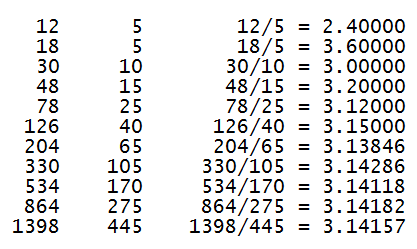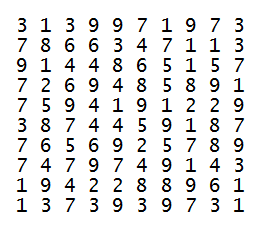- ALONE and UPRAISE can be beheaded twice and retain their essential meanings.
- Evelyn Waugh’s first wife was named Evelyn.
- 1033 = 81 + 80 + 83 + 83
- Can a shadow rotate?
- “Genius is nothing but a greater aptitude for patience.” — Benjamin Franklin
Science & Math
Math Notes
20864448472975628947226005981267194447042584001 = (2 + 0 + 8 + 6 + 4 + 4 + 4 + 8 + 4 + 7 + 2 + 9 + 7 + 5 + 6 + 2 + 8 + 9 + 4 + 7 + 2 + 2 + 6 + 0 + 0 + 5 + 9 + 8 + 1 + 2 + 6 + 7 + 1 + 9 + 4 + 4 + 4 + 7 + 0 + 4 + 2 + 5 + 8 + 4 + 0 + 0 + 1)20
Moving Without Motion?
Achilles-weed is prostrate and grows along the ground at the amazing rate of 10 cm per hour. An exceeding slow tortoise munches one end of the Achilles-weed at the same rate as it grows at the other end. So the tortoise appears to chase the Achilles-weed round the garden. But, strictly speaking, the Achilles-weed does not move at all, it grows and is eaten. Yet its location changes, and it is made up of parts whose location changes (the left and right-hand halves of the Achilles-weed). Hence being made up of parts whose location changes is not sufficient for motion.
— Peter Forrest, “Is Motion Change of Location?”, Analysis, 1984
A Pretty Problem
In Longfellow’s novel Kavanagh, Mr. Churchill reads a word problem to his wife:
“In a lake the bud of a water-lily was observed, one span above the water, and when moved by the gentle breeze, it sunk in the water at two cubits’ distance. Required the depth of the water.”
“That is charming, but must be very difficult,” she says. “I could not answer it.”
Is it? If a span is 9 inches and a cubit is 18 inches, how deep is the water?
Misc
- SWEET-TOOTHED has three consecutive pairs of letters. SUBBOOKKEEPER has four.
- Will you answer this question negatively?
- 4624 = 44 + 46 + 42 + 44
- The telephone number 278-7433 spells both ASTRIDE and CRUSHED.
- “Nothing great was ever achieved without enthusiasm.” — Emerson
Beach Reading
Amazon reviews of A Million Random Digits with 100,000 Normal Deviates (1955), by the RAND Corporation:
- “I had a hard time getting into this book. The profanity was jarring and stilted, not at all how people really talk.”
- “Once you get about halfway in, the rest of the story is pretty predictable.”
- “If you like this book, I highly recommend that you read it in the original binary.”
- “I would have given it five stars, but sadly there were too many distracting typos. For example: 46453 13987.”
- “I really liked the ‘10034 56429 234088’ part.”
- “Frankly the sex scenes were awkward and clumsily written, adding very little of value to the plot.”
- “For a supposedly serious reference work the omission of an index is a major impediment. I hope this will be corrected in the next edition.”
The average customer gives it four stars.
Misc
- EVIAN, SEIKO, and STROH’S are all English words spelled backward.
- Can “I apologize” be false?
- 165033 = 163 + 503 + 333
- Little Wymondley, in Hertfordshire, is bigger than Great Wymondley.
- “How old would you be if you didn’t know how old you was?” — Satchel Paige
A Surprise Visitor
Create two columns, one starting with the numbers 12 and 18 and the other with 5 and 5. Continue each column, deriving each new number by adding the two that precede it:

In the Journal of Recreational Mathematics, James Davis writes, “Forming successive pairs with adjoining numbers from each column one finds the ratio of the two numbers in each pair converges to π!” How can this be?
“The alert reader will suspect there is a trick in this method, as I did when π first presented it to me. The labor of several hours of computation coupled with trial and error produced half of the secret of the method. It is obviously based somehow on the fact that φ (the golden mean, which equals , can be closely approximated by the nifty pseudo equation below:”
“Can the reader decipher π’s technique for making herself with φ?”
Through and Through
3139971973786634711391448651577269485891759419122938744591877656925789747974914319
422889611373939731 is prime, whether it’s spelled forward or backward. Further, if it’s cut into 10 pieces:

… each row, column, and diagonal is itself a reversible prime.
Discovered by Jens Kruse Andersen.
A Man’s Home …

In 1922, after the death of his mother, Carl Jung felt “I had to achieve a kind of representation in stone of my innermost thoughts and of the knowledge I had acquired. Or, to put it another way, I had to make a confession of faith in stone.”
He began to build a structure on the shores of Lake Zurich in Switzerland. It began as a regular two-story house, “a maternal hearth,” but over the years he added a towerlike annex with a “retiring room” for withdrawal and contemplation, and a courtyard and loggia.
At 80, after his wife’s death, “I suddenly realized that the small central section which crouched so low, so hidden, was myself!” He added an upper story, an extension of his own personality no longer hidden behind the “maternal” and “spiritual” towers. “Now it signified an extension of consciousness achieved in old age. With that the building was complete.”
The final building, he saw, symbolized the structure of his own psyche, the full emergence of his personality in adulthood. “Unconsciously built at the time, only afterward did I see how all the parts fitted together and that a meaningful form had resulted: a symbol of psychic wholeness.” “At Bollingen,” he wrote, “I am in the midst of my true life, I am most deeply myself.”
